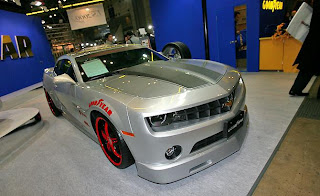History
In 2001
Roland Gumpert proposed a new generation
sports car. One of the first concerns of this car was that it be a street-legal car, ready for the race track. Gumpert returned to Germany at the end of 2001, after more than three years in China. There he was the head of sales and marketing, responsible for the development of the dealer network of the
Audi-
VW joint enterprise. Just after he returned to Germany,
Roland Mayer asked him if he would assist him in building a prototype sports car. Audi approved Gumpert's involvement in this project, on the condition that, if they did eventually develop a new sports car, it would not be a
prototype, but a series product.
[1]
The company, located in
Altenburg,
Germany, was founded in 2004 under the name GMG Sportwagenmanufaktur Altenburg GmbH. The technical guidelines were defined and the first designs of the car were drawn by
Marco Vanetta. Upon Vanetta's completion of this process, the first 1:4
scale model of Gumpert's car was produced in 2002.
Motorsport
During April 2005 the Apollo made its racing debut in the Divinol Cup. This Apollo was driven by the Belgian race driver
Ruben Maes. Maes finished third on the
Hockenheimring race track. Three years later Gumpert announced that they would enter a
hybrid version of the Apollo in the 2008
24 Hours Nürburgring, driven by 2004 winner
Dirk Müller and ex-
Formula One racer
Heinz-Harald Frentzen. Three months passed between the first discussions and the finished hybrid Apollo. The Apollo was driven in the 24 Hours Nürburgring in May 2008. The hybrid Apollo can deliver up to 382 kW (519 PS; 512 hp), powered with a 3.3 litre V8
twin-turboengine coupled with a 100 kW (136 PS; 134 hp) electric motor. The car has the ability to
recharge the battery under braking.
On July 27, 2008 an Apollo Sport was featured on the UK show
Top Gear.
Richard Hammond and
The Stigdrove the Apollo Sport.
[4] With a lap time of 1:17.1, the Apollo Sport is the fastest on the 'Power Lap Board' as of December 2009.
[5]
The Apollo is a 1,100 kg (2,400 lb) to 1,200 kg (2,600 lb) (depending on options), street-legal race car. It is a mid-engined, rear wheel drive two-seater constructed on a tubular
chromoly frame, with
fiberglass or optional
carbon fiber body panels. The manufacturers, Gumpert, claim the design of the Apollo is optimized so that the car could drive upside-down in a tunnel if driven at sufficiently high speeds (over 190 mph),
[6] though this remains to be tested.
Top Gear presenter Richard Hammond claims that Gumpert have already found a suitable tunnel and have made all the preparations necessary and are simply waiting for a volunteer driver willing enough to do the test.
[7]
Engine
A 4163 cc
bi-turbo intercooled V8 engine powers the Apollo. The 90° V8 has a closed-deck light metal crankcase with
dry sump lubrication. The light metal cylinder heads have five valves per cylinder, four overhead camshafts,
VarioCam Direct variable valve timing on the intakes, and hydraulic valve clearance compensation. The double-flow exhaust system has four
oxygen sensors to monitor the gas mixture, and a 3-way
catalytic converter. Modern controls include an on-board diagnostic system, eight-coil
electronic ignition, sequential multipoint
fuel injection, and an electronic (
drive by wire) accelerator system.
There are 3 engine types available, a base version with about 478 kW (650 PS; 641 hp), a sport version with around 515 kW (700 PS; 691 hp) and a race version with around 588.4 kW (800 PS; 789 hp) Top speed is 360.4 km/h (223.9 mph) with 0-100 km/h (62 mph) reached in 3.2 seconds and 0-200 km/h (120 mph) in 8.8 seconds.
[edit]Dimensions
- Length: 4,460 mm (176 in)
- Width: 1,998 mm (78.7 in)
- Height: 1,114 mm (43.9 in)
- Wheel Base: 2,700 mm (110 in)
Weight
- Curb Weight: under 1,200 kg (2,600 lb)
- Total Allowed Weight: 1,500 kg (3,300 lb)












































